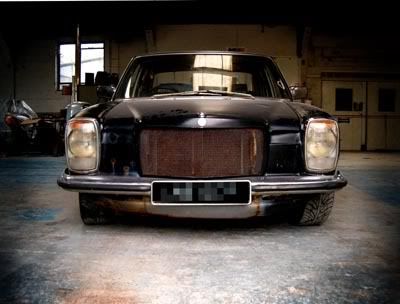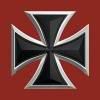Shamelessly nicked from the oz benz club forum, next time Mr Clarkson assures us Mercedes never rallied you can point and laugh. 
The following article appeared in the June/July 2005 issue of "Das Rundschreiben", the magazine of the Mercedes-Benz Club (NSW) Inc.
The 5-Litre SLC Rally Cars
Researched by Greg - MBCNSW 107 Series Registrar.
From the mid 1950s to the mid 1960s Mercedes-Benz cars were seen in rally competition, initially as the legendary 300SL, then the 220SE, the 230SL and finally the 300SE. A period of around twelve years then elapsed before Mercedes-Benz cars were again seen in rallies.
In 1977 a crew comprising Andrew Cowan, Colin Malkin and Mike Broad were victorious in a W123 series 280E in the 18,000km London to Sydney Rally and a similar 280E of Fowkes and O'Gorman came in second. The following year the 280E of Zasada and Krupa finished sixth in the African Safari Rally.
Daimler-Benz realised that their cars had the necessary durability for rallies and that with more power they could achieve further success. While other manufacturers were rallying small to medium sized cars, Daimler-Benz decided that following their experiences with the 280E, the coupe version of their 107 series was the car to use. The "SL" in SLC was supposed to stand for "sports-light" but this was not an accurate description of the long and heavy SLC coupe, at the time the flagship of the Mercedes-Benz range aimed at the upper end of the luxury market. With V8 engines it was however a fast tourer. The fixed roof of the SLC added to the body rigidity of the SL and the superb handling, together with the comfort of the long wheelbase coupe, meant that crews would suffer the minimum of fatigue over long rallies.
The 107 series had been released in 1971 with the 200 horsepower (147kW) 3.5-litre M116 V8 initially as the 350SL 2-seat roadster and then as the 350SLC 5-seat coupe. Subsequently the 225hp (165kW) 4.5-litre M117 V8 was added to the range in the 450SL and 450SLC with the 185hp (136kW) 2.8-litre twin-cam M110 six-cylinder from the 280E added later still. In 1978 a new all-alloy 240 horsepower (177kW) V8 engine of 5,025cc was developed specifically for the rally version of the SLC. Previously all 107 models used engines with alloy cylinder heads on cast iron cylinder blocks. Together with a lightweight aluminium bonnet and boot lid, the new engine also assisted in reducing the substantial weight of the big coupe and the resulting car became known as the 450SLC-5.0. Despite the light alloy block, the 5-litre engine retained the M117 designation and the remainder of the rally version of the 450SLC-5.0 differed little from the standard 450SLC, including the 3-speed torque converter automatic transmission.
The month-long 30,000km 1978 Vuelta America del Sud (Tour of South America) was chosen as the debut event for the SLC rally car. A 450SLC-5.0 crewed by Andrew Cowan and Colin Malkin won the rally with second place going to Zasada and Zembruski also in an SLC, third to Fowkes and Kaiser in a 280E and fourth to Makinen in the remaining SLC. Only about one third of all the entered cars survived the gruelling rally, however all four SLC and three of the four 280E Mercedes entered completed the event.
For 1979 the 450SLC-5.0 was homologated as a Group 4 rally car with power being increased to around 300hp (220kW) and further weight reductions resulted from stripped-out interiors. Three-speed automatic transmission was retained as it was considered the only Daimler-Benz unit capable of withstanding the torque of the V8. Massive factory support under the leadership of Eric Waxenberger backed the effort behind several entries in the 1979 World Rally Championship. Three each 450SLCs and 280Es were entered in the African Safari Rally and SLCs driven by Bjorn Waldegard and Hannu Mikkola led for much of the event. Mikkola and Hertz finished a close second with Cowan and Syer in a 280E in fourth and Waldegard sixth. Greater success was achieved with a clean sweep of the 5,500km Bandama (Ivory Coast) Rally with four 450SLC-5.0s driven by Mikkola, Waldegard, Cowan and Preston taking positions 1, 2, 3 and 4 respectively.
Following the 1978 and 1979 successes, an even greater effort went into the 1980 season. The Portugal Rally resulted in a best of only fourth place for Waldegard and Thorszelius and it was becoming obvious the big SLC was not so suited to the shorter and tighter European rallies. In the 5,300km Safari Rally where success was expected, rear suspension failures saw a best of third place to Vic Preston Junior in a 450SLC-5.0 using the newly introduced four-speed automatic transmission. In the Acropolis Rally the power of the 5 litre SLCs resulted in shredded tyres on the rocky roads with the highest placing again going to Preston this time down in fourteenth place.
For the Rally of Argentina engine output increased to 340hp (250kW) despite a slight reduction in displacement to 4,975cc. The cars became known as a 500SLC and were now homologated as Group 2. Mikkola and Hertz managed second place however two other 500SLCs suffered broken drive shafts. In the Rally of New Zealand Mikkola finished third and Waldegard fifth. In the same event Cowan suffered rear brake problems. Following a call over the radio, a helicopter was soon seen flying with an entire replacement rear axle assembly slung underneath, such was the level of factory support. The final event contested for 1980 was the Ivory Coast Rally better suited to the big fast SLC. The rate of attrition across all entrants was huge including Cowan who crashed. A total of just eleven cars finished with first to Bjorn Waldegard, second to Jorge Recalde and fifth to Vic Preston, all in 500SLCs.
Not entering every event for the 1980 season resulted in Mercedes finishing fourth overall in the championship. Mercedes recruited winning driver Walter Rohl who had been driving for Fiat in preparation for the following year. With the realisation that the SLC was just too big for the European rallies, plans were to use the similar but shorter 500SL for 1981. This was never to eventuate and the 1980 champion was left without a drive for 1981. Daimler-Benz again had a break from motor sport for a few years until the introduction of the W201 series 190E 2.3-16 destined for circuit racing, but that is another story.
The 350 and 450SLC (like the 350 and 450SL) had been discontinued in 1980 with the introduction of the 380 and 500SLC. The 280, 380 and 500SLC were discontinued in 1981 with the introduction of the 126 series 380 and 500SEC coupes. A total of 62,888 SLCs had been manufactured over a ten year period of which just 1,636 were the 450SLC-5.0 and 1,133 were the 500SLC. Both these models are sought by collectors today. Unfortunately they were not sold in Australia. The SLC remains the only fixed roof Mercedes-Benz coupe based on a roadster rather than a sedan. Even today, an SLC in good mechanical condition still gives a mix of good performance, superb handling, comfort and safety, making it is easy to realise why they were a successful rally car. Following the discontinuation of the SLC, the 107 series continued initially as the 280, 380 and 500SL and then finally as the 300, 420, 500 and 560SL until 1989. This eighteen-year run makes the 107 series the longest running series produced by Daimler-Benz.
Edit: Having recently purchased a 500SLC, I have been corresponding with other knowledgeable owners of these 5 litre SLC models overseas. They have been able to confirm that the information I quoted in this article I wrote over 18 months ago is correct except for the fact that the 450SLCs which made their rally debut in the 1978 Vuelta America del Sud (Tour of South America) may have run with the iron block 4.5 litre engines. The 5 litre alloy engines were definitely used for all subsequent events. I also stated that the 5 litre alloy V8 first appeared in the SLC in 1978. This actually occured late in 1977.
Greg

























The following article appeared in the June/July 2005 issue of "Das Rundschreiben", the magazine of the Mercedes-Benz Club (NSW) Inc.
The 5-Litre SLC Rally Cars
Researched by Greg - MBCNSW 107 Series Registrar.
From the mid 1950s to the mid 1960s Mercedes-Benz cars were seen in rally competition, initially as the legendary 300SL, then the 220SE, the 230SL and finally the 300SE. A period of around twelve years then elapsed before Mercedes-Benz cars were again seen in rallies.
In 1977 a crew comprising Andrew Cowan, Colin Malkin and Mike Broad were victorious in a W123 series 280E in the 18,000km London to Sydney Rally and a similar 280E of Fowkes and O'Gorman came in second. The following year the 280E of Zasada and Krupa finished sixth in the African Safari Rally.
Daimler-Benz realised that their cars had the necessary durability for rallies and that with more power they could achieve further success. While other manufacturers were rallying small to medium sized cars, Daimler-Benz decided that following their experiences with the 280E, the coupe version of their 107 series was the car to use. The "SL" in SLC was supposed to stand for "sports-light" but this was not an accurate description of the long and heavy SLC coupe, at the time the flagship of the Mercedes-Benz range aimed at the upper end of the luxury market. With V8 engines it was however a fast tourer. The fixed roof of the SLC added to the body rigidity of the SL and the superb handling, together with the comfort of the long wheelbase coupe, meant that crews would suffer the minimum of fatigue over long rallies.
The 107 series had been released in 1971 with the 200 horsepower (147kW) 3.5-litre M116 V8 initially as the 350SL 2-seat roadster and then as the 350SLC 5-seat coupe. Subsequently the 225hp (165kW) 4.5-litre M117 V8 was added to the range in the 450SL and 450SLC with the 185hp (136kW) 2.8-litre twin-cam M110 six-cylinder from the 280E added later still. In 1978 a new all-alloy 240 horsepower (177kW) V8 engine of 5,025cc was developed specifically for the rally version of the SLC. Previously all 107 models used engines with alloy cylinder heads on cast iron cylinder blocks. Together with a lightweight aluminium bonnet and boot lid, the new engine also assisted in reducing the substantial weight of the big coupe and the resulting car became known as the 450SLC-5.0. Despite the light alloy block, the 5-litre engine retained the M117 designation and the remainder of the rally version of the 450SLC-5.0 differed little from the standard 450SLC, including the 3-speed torque converter automatic transmission.
The month-long 30,000km 1978 Vuelta America del Sud (Tour of South America) was chosen as the debut event for the SLC rally car. A 450SLC-5.0 crewed by Andrew Cowan and Colin Malkin won the rally with second place going to Zasada and Zembruski also in an SLC, third to Fowkes and Kaiser in a 280E and fourth to Makinen in the remaining SLC. Only about one third of all the entered cars survived the gruelling rally, however all four SLC and three of the four 280E Mercedes entered completed the event.
For 1979 the 450SLC-5.0 was homologated as a Group 4 rally car with power being increased to around 300hp (220kW) and further weight reductions resulted from stripped-out interiors. Three-speed automatic transmission was retained as it was considered the only Daimler-Benz unit capable of withstanding the torque of the V8. Massive factory support under the leadership of Eric Waxenberger backed the effort behind several entries in the 1979 World Rally Championship. Three each 450SLCs and 280Es were entered in the African Safari Rally and SLCs driven by Bjorn Waldegard and Hannu Mikkola led for much of the event. Mikkola and Hertz finished a close second with Cowan and Syer in a 280E in fourth and Waldegard sixth. Greater success was achieved with a clean sweep of the 5,500km Bandama (Ivory Coast) Rally with four 450SLC-5.0s driven by Mikkola, Waldegard, Cowan and Preston taking positions 1, 2, 3 and 4 respectively.
Following the 1978 and 1979 successes, an even greater effort went into the 1980 season. The Portugal Rally resulted in a best of only fourth place for Waldegard and Thorszelius and it was becoming obvious the big SLC was not so suited to the shorter and tighter European rallies. In the 5,300km Safari Rally where success was expected, rear suspension failures saw a best of third place to Vic Preston Junior in a 450SLC-5.0 using the newly introduced four-speed automatic transmission. In the Acropolis Rally the power of the 5 litre SLCs resulted in shredded tyres on the rocky roads with the highest placing again going to Preston this time down in fourteenth place.
For the Rally of Argentina engine output increased to 340hp (250kW) despite a slight reduction in displacement to 4,975cc. The cars became known as a 500SLC and were now homologated as Group 2. Mikkola and Hertz managed second place however two other 500SLCs suffered broken drive shafts. In the Rally of New Zealand Mikkola finished third and Waldegard fifth. In the same event Cowan suffered rear brake problems. Following a call over the radio, a helicopter was soon seen flying with an entire replacement rear axle assembly slung underneath, such was the level of factory support. The final event contested for 1980 was the Ivory Coast Rally better suited to the big fast SLC. The rate of attrition across all entrants was huge including Cowan who crashed. A total of just eleven cars finished with first to Bjorn Waldegard, second to Jorge Recalde and fifth to Vic Preston, all in 500SLCs.
Not entering every event for the 1980 season resulted in Mercedes finishing fourth overall in the championship. Mercedes recruited winning driver Walter Rohl who had been driving for Fiat in preparation for the following year. With the realisation that the SLC was just too big for the European rallies, plans were to use the similar but shorter 500SL for 1981. This was never to eventuate and the 1980 champion was left without a drive for 1981. Daimler-Benz again had a break from motor sport for a few years until the introduction of the W201 series 190E 2.3-16 destined for circuit racing, but that is another story.
The 350 and 450SLC (like the 350 and 450SL) had been discontinued in 1980 with the introduction of the 380 and 500SLC. The 280, 380 and 500SLC were discontinued in 1981 with the introduction of the 126 series 380 and 500SEC coupes. A total of 62,888 SLCs had been manufactured over a ten year period of which just 1,636 were the 450SLC-5.0 and 1,133 were the 500SLC. Both these models are sought by collectors today. Unfortunately they were not sold in Australia. The SLC remains the only fixed roof Mercedes-Benz coupe based on a roadster rather than a sedan. Even today, an SLC in good mechanical condition still gives a mix of good performance, superb handling, comfort and safety, making it is easy to realise why they were a successful rally car. Following the discontinuation of the SLC, the 107 series continued initially as the 280, 380 and 500SL and then finally as the 300, 420, 500 and 560SL until 1989. This eighteen-year run makes the 107 series the longest running series produced by Daimler-Benz.
Edit: Having recently purchased a 500SLC, I have been corresponding with other knowledgeable owners of these 5 litre SLC models overseas. They have been able to confirm that the information I quoted in this article I wrote over 18 months ago is correct except for the fact that the 450SLCs which made their rally debut in the 1978 Vuelta America del Sud (Tour of South America) may have run with the iron block 4.5 litre engines. The 5 litre alloy engines were definitely used for all subsequent events. I also stated that the 5 litre alloy V8 first appeared in the SLC in 1978. This actually occured late in 1977.
Greg
































 . They fetch strong money.
. They fetch strong money.

















